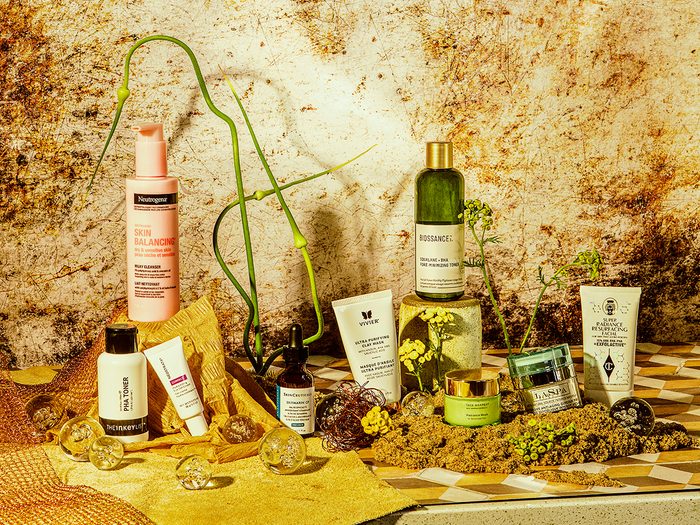
An in-the-know guide to four powerful active ingredients
When it comes to skin care, knowledge is power, and we’re getting smarter. “Since the pandemic, people are actively seeking information through online tutorials and masterclasses,” says Patricia Clare, a Vancouver-based national trainer for NeoStrata, an anti-aging skin care line. “They’re really trying to put it together. I’ve never seen anything quite like it.” Understanding that desired results are anchored to key ingredients is part of the journey to building a skincare routine that works, and so is an introduction to acid ingredients.
“Traditionally, acids are mostly keratolytics, which are ingredients that help the skin turn over and shed [dead cells] properly,” says Dr. Geeta Yadav, a dermatologist at Skin Science Dermatology in Toronto, “They add brightening and renewal – the glow effect.” But wait, there’s more! Beyond that core group of chemical exfoliants, you’ll find other notable acids that can elevate a routine by increasing hydration or reducing blemishes.
And despite the harsh name, you don’t need a drastic reason to consider incorporating an acid ingredient into your skin care routine. According to Clare, observing that something is suddenly different (such as the onset of clogged pores, skin that’s rougher or discolouration) is a legit motive to prompt an investigation. Read on to learn more about popular acid ingredients, and know this: “It’s not about which one is the best acid,” says Clare, “but which is the best one for you.”
Note: Generally, acids can be used in a routine that also includes retinol, another powerful active ingredient, however due to retinol’s innate sloughing action, layering it with acids is not advised and can increase potential skin irritation.
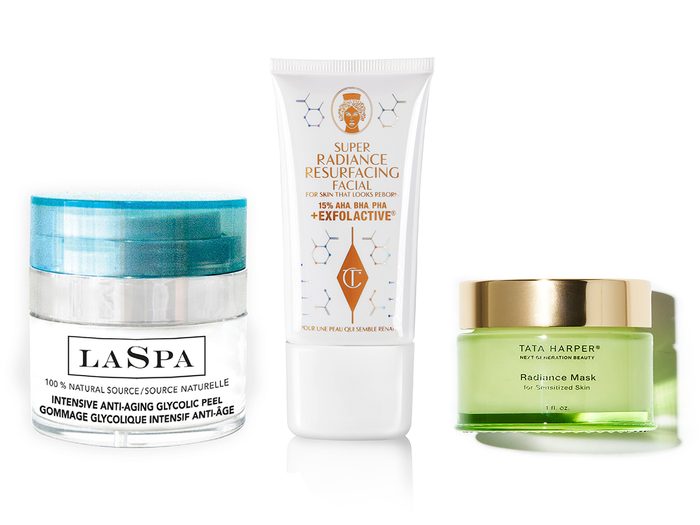
AHAs
Alpha Hydroxy Acids (AHAs) are a group of ingredients that dissolve the bonds between dead skin cells. “AHAs have that turnover effect,” says Yadav, “They also increase collagen production and decrease melanin production.” Prevalent types include glycolic, lactic, mandelic, tartaric and citric acid, with the former the most well-known of the bunch. “The reason glycolic acid is the kingpin of AHAs is that it has the smallest molecular weight, so it’s quickest [to get] into the skin,” says Clare, who likes the ingredient for a range of objectives. Using glycolic acid to get rid of dead skin cells can help unify a combination complexion, helping dry areas hold on to moisture better and reduce breakouts for oilier parts, she says.
Best for: normal and/or combination skin.
Try:
1. Made with natural and organic ingredients, this treatment utilizes glycolic and hyaluronic acids to exfoliate while hydrating.
LASPA Intensive Glycol Peel (10%) Overnight Treatment, $130, thedetoxmarket.ca
2. With a hefty mix of acids and a luxe gel texture, this weekly treatment reveals radiance in 20 minutes.
Charlotte Tilbury Super Radiance Resurfacing Facial, $85, charlottetilbury.com
3. This mild and nourishing blend features phytic and lactic acids to gently promote cell turnover.
Tata Harper Superkind Radiance Mask for Sensitized Skin, $87, tataharperskincare.com
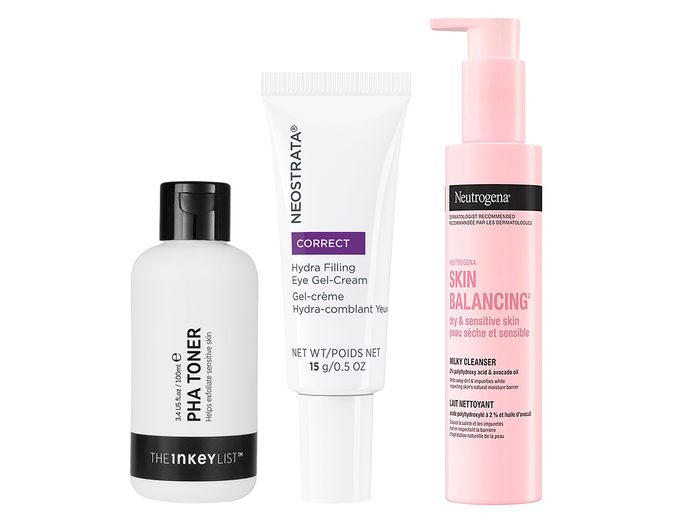
PHA
Discovered in the 1990s, polyhydroxy acids (PHAs) in skin care aren’t new – but they have started to get more well-deserved attention. “If AHAs are the workhorse of exfoliants, PHAs are the pretty ponies. They still do the job, but do it delicately,” says Clare. Commonly listed as gluconolactone or lactobionic acid, PHAs balance gentle exfoliation with a dose of moisture. Plus, they have an antioxidant effect, helping to reduce inflammation and oxidative damage from the environment which can be aging to the look and feel of skin.
Best for: Dry, sensitive, fragile or stressed skin.
Try:
1. This daily treatment gently brushes away dullness and dryness.
The INKEY List PHA Toner, $14, sephora.com
2. PHAs, plus hyaluronic acid, help to smooth fine lines and firm the eye area.
NeoStrata Hydra Filling Eye Gel-Cream, $48, neostrata.ca
3. An alcohol-free cleanser with 2% PHA removes dirt and impurities without stripping skin.
Neutrogena Skin Balancing Sensitive & Dry Skin Milky Cleanser, $17, shoppersdrugmart.ca
(Related: 5 Skin Care Ingredients You Should Never Mix—and 4 You Should)
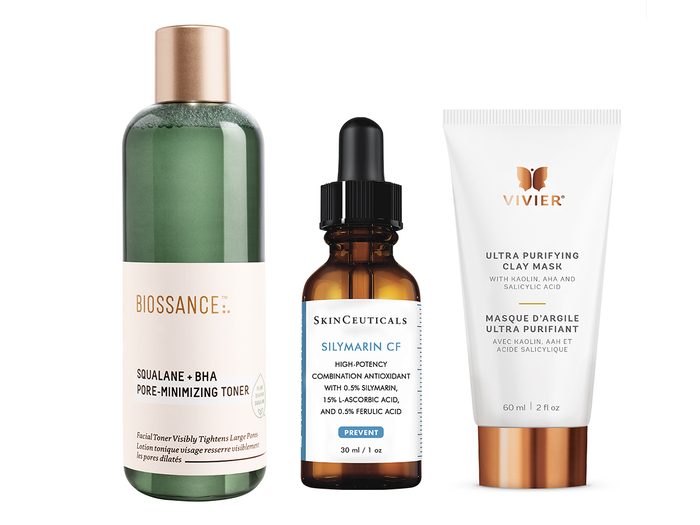
BHA
Under the banner of Beta Hydroxy Acids (BHAs), salicylic acid is the solo star. It’s excellent at helping the top layer of skin shed dead cells, says Yadav. It’s oil soluble, which means it can clear out sebum in clogged pores, so it’s a go-to for acne treatments. “Salicylic acid works by a top-down approach, layer by layer, says Dr. Yadav. Powerful on its own, some formulations may combine this BHA with other acids to further enhance your complexion.
Best for: Congested pores, breakout and acne-prone skin
Try:
1. Clear pores lead to a smoother complexion, this toner whisks away sebum without over-stripping.
Biossance Squalane + BHA Pore-Minimizing Toner, $37, biossance.com
2. Formulated specifically to balance oily skin, this antioxidant serum combines salicylic acid with Vitamin C.
SkinCeuticals Silymarin CF, $190, skinceuticals.ca
3. Kaolin clays, AHAs and salicylic acid clear congestion, while arnica, calendula and Vitamin E are calming.
Vivier Ultra Purifying Clay Mask, $68, vivierskin.ca
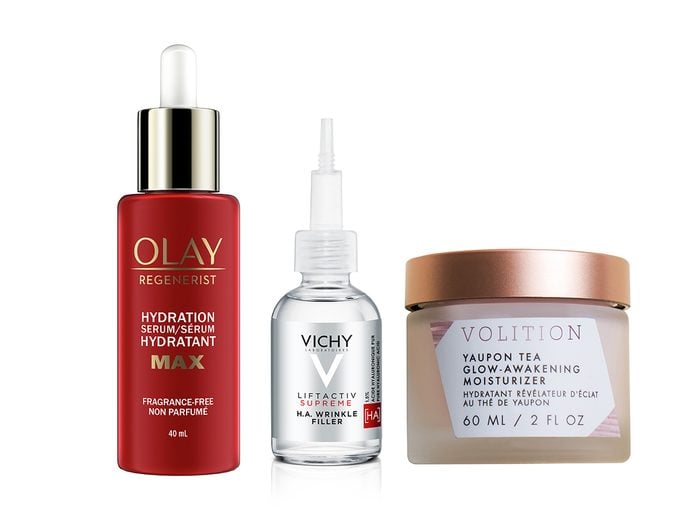
HA
If hyaluronic acid (known as HA) has zero exfoliating power, what makes it the buzziest acid of late? Its ability to hold a thousand times its weight in water, that’s what. HA is also a naturally occurring component of the epidermis that contributes to youthful volume and a hydrated texture, and it diminishes with age. Often formulated with various sizes of molecules to help plump the surface as well as draw moisture deeper into the epidermis, hyaluronic acid is a fast-acting solution for when skin feels parched. It’s also plays well with retinol, before or after application. “Dehydration isn’t a skin type, it’s a skin condition. We all get it and it’s fast to correct,” Clare says, “HA is like Gatorade for thirsty skin.” Try her pro tip to quickly relieve a mask-weary face: apply a thin layer of a HA-loaded eye cream to friction points along the upper cheekbones.
Best for: any occurrence of dehydrated skin
Try:
1. HA and niacinamide, a regenerative powerhouse, create a lightweight serum that offers long-lasting moisture benefits.
Olay Regenerist MAX Hydration Serum, $55, at shoppersdrugmart.ca and drugstores
2. A fragrance-free targeted treatment that mixes 1.5% hyaluronic acid with Vitamin C and peptides to address fine lines.
Vichy Liftactiv H.A. Wrinkle Filler Face & Eye Serum, $63, vichy.ca and drugstores
3. Caffeinated tea leaf is bolstered by HA to deliver a perfectly hydrating wake-up call.
Volition Yaupon Tea Glow-Awakening Moisturizer, $52, sephora.com
